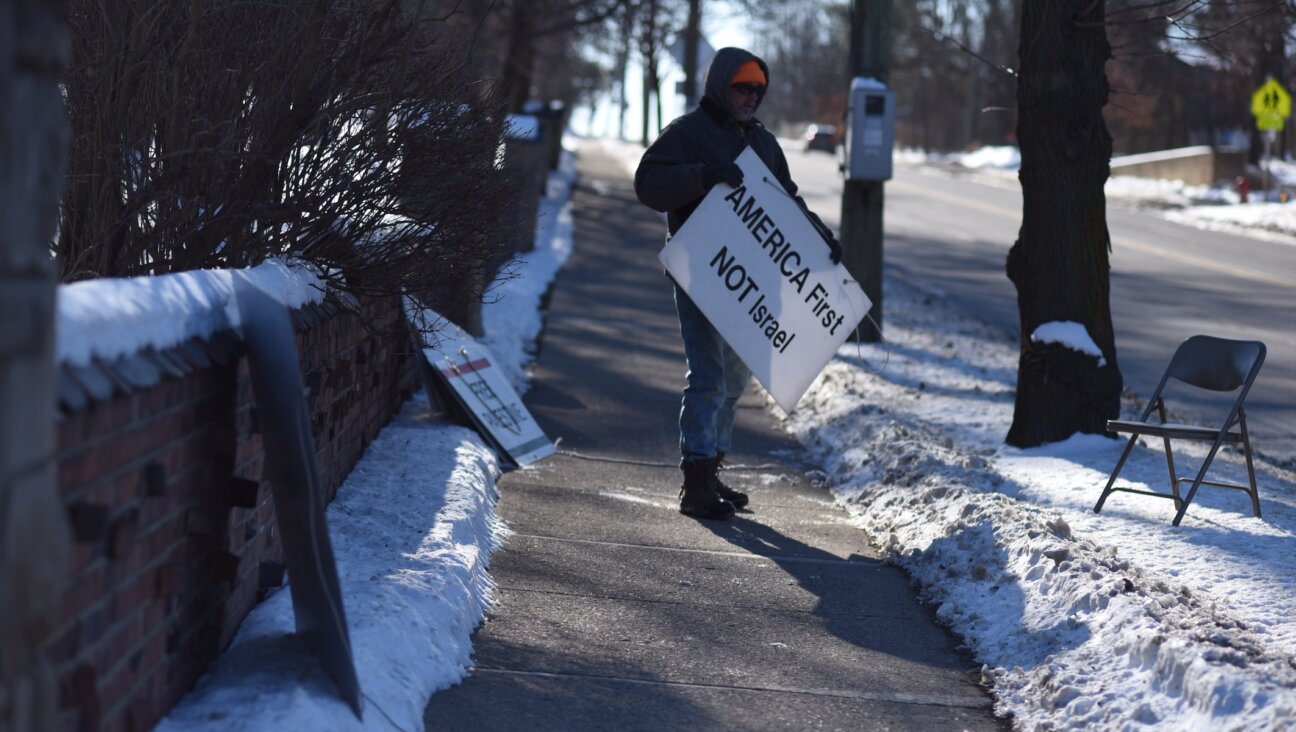Jews Are Still the Biggest Target of Religious Hate Crimes

Members of the National Socialist Movement march in front of Los Angeles’ City Hall in 2010. Image by Getty Images
When it comes to religious hate crimes, Jews and Jewish institutions were the biggest targets in America again last year, hands down.
But when it comes to hate crimes overall, the single biggest motivation by far was not religion at all; it was race—a situation that has prevailed for years.
Those are two of the takeaways the public can glean from the FBI’s recently released annual review of hate crimes for 2014.
And then there’s the good news: Hate crimes overall were down by almost 8% compared with the results in 2013 — except for hate crimes against Muslims and Muslim institutions, which rose by 14%. The number of hate crimes targeting Jews, meanwhile, fell slightly, by about 2.5%.
Critics have long warned against taking the annual statistical review of hate crimes released by the FBI’s Uniform Crime Reporting Program too literally. The review, released November 16, is a database compiled from bias and hate crime counts submitted to the FBI by local police agencies across the country on a voluntary basis. Each local force uses its own methods for counting and categorizing. Studies by the Justice Department’s own Bureau of Justice Statistics, among others, suggest that the FBI numbers are consequently much lower than the real level of hate crimes. Police units in Hawaii, for example, do not participate in the program at all.
Still, many consider the annual review to be at least a helpful indicator of broad patterns. This year, some 86% of the nation’s nearly 18,000 law enforcement agencies submitted hate crime reports to the FBI, one of the highest percentages in recent years, according to the Southern Poverty Law Center.

Image by Anya Ulinich
The FBI found that rates for hate crimes fell by almost 8% last year, when more than 6,400 hate crimes were reported, compared with nearly 7,000 in 2013. According to the data, 47% of these 2014 hate crimes were motivated by racial prejudice. Crimes motivated by religious and sexual orientation were next, at 18.6% each. These were followed by crimes motivated by ethnicity (11.9%), gender identity (1.8%), disability (1.5%) and gender (0.6%).
Last year, as in previous years, Jews were the most frequent victims of reported crimes targeting members of a religious group. Of the 1,140 reported victims of anti-religious hate crimes, 648, or almost 57%, were Jewish. Looked at another way, of the 1,014 reported anti-religious hate crime incidents (some of which had multiple victims), 609, or slightly more than 60%, targeted Jews.
Where data details submitted by the local law enforcement agencies make it possible, the FBI report identifies perpetrators by race and ethnicity; but not by religion. Of the anti-Jewish hate crime perpetrators whose ethnicity could be identified, 87 were white and 20 were African American. Another 231 of the known offenders were of unknown race.
Muslims were the second most frequent target of anti-religious crimes. They were targeted in 154, or 15.2%, of such reported incidents. These crimes resulted in 184 victims, or 16.1% of the total.
A significant number of the anti-Jewish hate crimes – 451 – consisted of vandalism or some other type of property damage. The numbers for more serious offenses against Jews were roughly the same as for more serious offenses against Muslims. There were more aggravated assaults and robberies committed against Muslims, and more simple assaults, intimidations, burglaries, thefts, and arson offenses against Jews. There were no reported hate crime murders of Muslims last year.
If you take the FBI statistics at face value, there were also no murders targeting Jews last year. But in fact, the report omitted three shocking anti-Jewish murders during this period.
On November 10 a Kansas court sentenced Frazier Glenn Miller Jr., also known as Frazier Glenn Cross Jr., to death following his conviction for three murders in April 2014, two outside the Jewish Community Center of Greater Kansas City, in Overland Park, Kansas, and one outside Village Shalom retirement center in the same suburb. According to The Associated Press, Miller, whom the Southern Poverty Law Center identified as a former grand dragon of the Ku Klux Klan, said he shot his victims because he wanted to kill Jewish people before he dies.
As it happened, none of the victims was Jewish. Nevertheless, according to the FBI’s chief of multimedia productions, Stephen G. Fischer Jr., what matters for purposes of FBI hate crime statistics is the perpetrator’s intent.
The failure of these murders to show up at all in the FBI’s report reflects some of the pitfalls in the nature and the methodology of the bureau’s data gathering. In this case, it seems, there was a complete disconnect between the UCR Program and the state agency that submitted data to it.
The FBI’s Uniform Crime Reporting Program, Fischer explained by email, categorizes hate crimes according to the group that was the intended target. “Even if the offender was mistaken about the victim’s race, religion, disability, sexual orientation, ethnicity, gender or gender identity, the offense is still a hate crime as long as the offender was motivated, in whole or in part, by bias against that group,” he said.
Nevertheless, the 2014 statistics failed to note any homicides against Jews. This is not because the FBI doubts that Miller targeted Jews. In a speech to an Anti-Defamation League national conference in April 2014, FBI director James Comey had this to say about Miller: “He targeted individuals who were strangers to him, for no other reason than that he believed they were Jewish.”
The problem, Fischer indicated, was with the data Kansas submitted. Overland Park submits quarterly hate crime data to a central reporting center in Kansas, he explained, and the Kansas Bureau of Investigation then forwards the data to the FBI’s data-gathering program. In 2014, he added, the Overland Park Police Department reported only one 2014 bias incident, and it did not include the murders.
Kansas admitted it had dropped the ball in the process of transitioning from paper to electronic reporting. “Kansas has been implementing these changes gradually as time and budgets allow,” said Bill Reid, a research analyst with the Kansas Bureau of Investigation, in an email exchange with the Forward.
According to Reid, due to this transition and several changes in the reporting process at the federal level, Kansas law enforcement agencies did not submit hate crime data to the FBI until this year, for the annual report that will come out in 2016. Yet inexplicably, as Fischer noted, Overland Park did, in fact, submit 2014 hate crime data about one racial incident, but it did not report three murders targeting Jews.
Reid acknowledged, “This horrendous act [the three murders] would have definitely been classified as a hate crime (anti-Jewish).”
Asked whether the FBI would correct its report’s data showing no murders targeting Jews, Fischer simply quoted Reid’s admission that Kansas had not formally reported the incident to the FBI as a hate crime.
Contact Johanna Markind at [email protected]
















